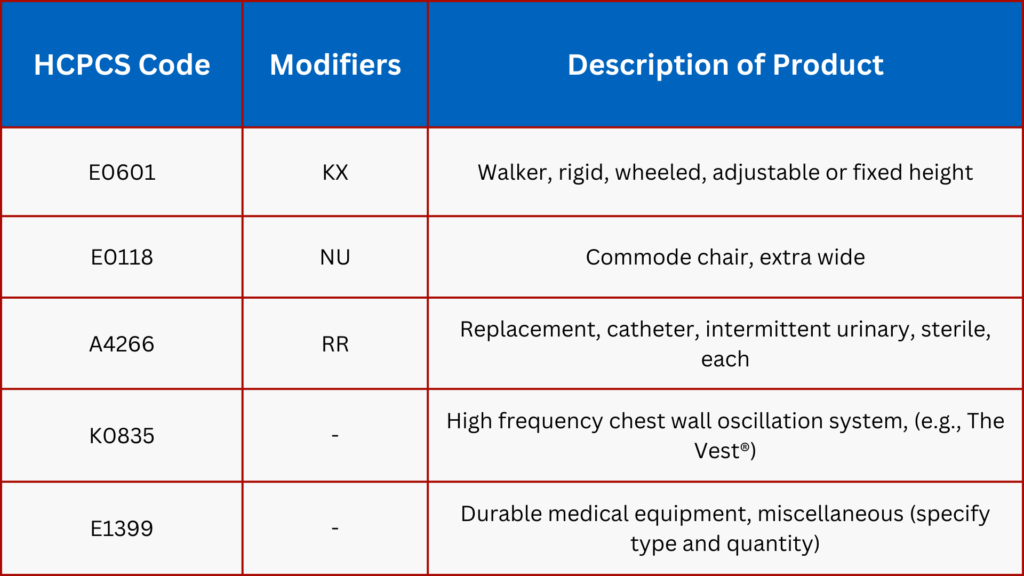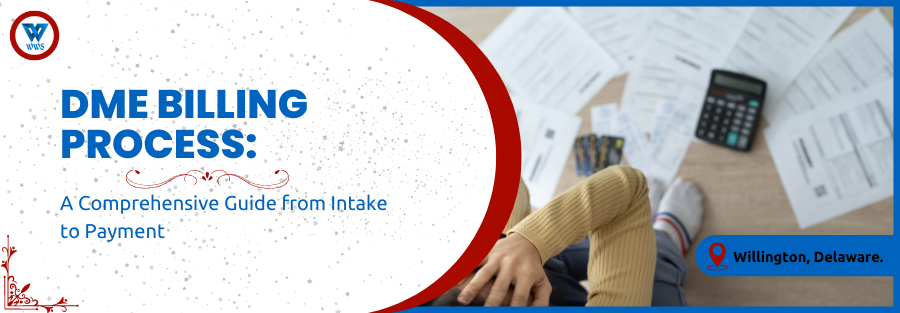Introduction to DME Billing
Durable Medical Equipment (DME) plays a crucial role in patient care, providing necessary medical devices for use in the home. The DME billing process is complex, involving multiple steps from patient intake to final payment. This guide will walk you through each stage of the DME billing lifecycle, offering insights and best practices along the way.
Patient Intake and Insurance Verification
The DME billing process begins with patient intake and insurance verification.
Collecting Patient Information
- Gather demographic details
- Obtain signed consent forms
- Collect referring physician information
Verifying Insurance Coverage
- Check primary and secondary insurance
- Verify policy status and effective dates
- Confirm DME benefits and coverage limits
Determining Patient Responsibility
- Calculate estimated co-pays and deductibles
- Discuss financial responsibilities with the patient
- Obtain advance beneficiary notice (ABN) if necessary
Prescription and Documentation
Proper documentation is crucial for successful DME billing.
Requirements for Valid DME Prescriptions
- Patient’s name and date of birth
- Specific equipment or supply ordered
- Quantity and duration of need
- Prescriber’s signature and NPI
Gathering Clinical Documentation
- Collect relevant medical records
- Obtain test results supporting medical necessity
- Ensure documentation meets payer-specific requirements
Prior Authorization
Many DME items require prior authorization from the payer.
When Prior Authorization is Required
- Check payer-specific guidelines
- Verify requirements for specific HCPCS codes
- Understand timelines for authorization requests
Steps to Obtain Prior Authorization
- Gather required documentation
- Submit request to the payer
- Follow up on pending authorizations
- Document approval or denial
Tracking Authorization Requests
- Implement a system to monitor authorization status
- Set reminders for follow-ups
- Keep detailed records of all communications with payers
Equipment Delivery and Set-up
Proper delivery and set-up are crucial steps in the DME process.
Coordinating Equipment Delivery
- Schedule delivery with the patient
- Ensure timely delivery within payer guidelines
- Coordinate with clinical staff for complex equipment
Documenting Proof of Delivery
- Obtain patient or caregiver signature
- Record date and time of delivery
- Document serial numbers of delivered equipment
Patient Education
- Provide instructions on equipment use and maintenance
- Offer contact information for support
- Schedule follow-up if necessary
Coding and Charge Entry
Accurate coding is essential for proper reimbursement.
Selecting Appropriate HCPCS Codes
- Use current HCPCS Level II codes
- Ensure codes match the delivered equipment
- Verify code coverage with the payer
Applying Relevant Modifiers
- Understand common DME modifiers (NU, RR, KX, etc.)
- Apply modifiers accurately to reflect service provided
- Be aware of payer-specific modifier requirements
Determining Correct Units of Service
- Follow payer guidelines for billing units
- Understand billing frequencies for recurring supplies
- Properly code for rental periods

Claim Preparation and Submission
Proper claim preparation is crucial for timely reimbursement.
Completing Claim Forms
- Use CMS-1500 for most DME claims
- Ensure all required fields are completed accurately
- Include any necessary attachments
Electronic vs. Paper Claim Submission
- Utilize electronic submission when possible for faster processing
- Follow payer guidelines for submission method
- Maintain records of all submitted claims
Attaching Required Documentation
- Include proof of delivery
- Attach medical necessity documentation when required
- Ensure all attachments are clearly labeled and legible
Payment Posting and Reconciliation
Accurate payment posting is essential for proper accounting and follow-up.
Processing Payments
- Post payments promptly upon receipt
- Allocate payments to the correct patient accounts and claims
- Handle electronic funds transfers (EFTs) and paper checks
Reconciling Payments with Submitted Claims
- Compare payments to expected reimbursement
- Identify and investigate any discrepancies
- Update patient accounts with insurance and patient payments
Handling Partial Payments and Adjustments
- Determine reasons for partial payments
- Apply contractual adjustments accurately
- Identify need for appeals or additional billing to patients
Follow-up on Unpaid Claims
Proactive follow-up is key to maintaining healthy cash flow.
Tracking Claim Status
- Implement a system to monitor unpaid claims
- Set timelines for follow-up based on payer guidelines
- Utilize payer portals and electronic claim status inquiries
Addressing Claim Rejections and Denials
- Identify root causes of rejections and denials
- Correct and resubmit rejected claims promptly
- Develop a systematic approach to appeal denials
Resubmission and Appeal Processes
- Understand timely filing limits for resubmissions
- Gather additional documentation for appeals
- Follow payer-specific appeal procedures
Billing for Rentals and Supplies
DME often involves ongoing rentals and supply deliveries, requiring special billing considerations.
Recurring Billing for Rental Equipment
- Understand rental periods and payment caps
- Bill at the appropriate frequency (e.g., monthly)
- Track rental payments towards purchase price
Managing Supply Reorders and Shipments
- Implement a system for tracking supply usage and reorder dates
- Verify continued medical necessity before shipping
- Ensure timely delivery of supplies
Tracking Rental Periods and Purchase Options
- Monitor rental durations against payer limits
- Understand when ownership transfers to the patient
- Bill appropriately for purchased equipment after rental period
Compliance and Auditing
Maintaining compliance is crucial in DME billing.
Importance of Compliance
- Understand relevant laws and regulations (e.g., Stark Law, Anti-Kickback Statute)
- Develop and maintain a compliance program
- Train staff regularly on compliance issues
Conducting Internal Audits
- Perform regular audits of claims and documentation
- Identify and correct any issues found during audits
- Use audit results to improve processes and training
Preparing for External Audits
- Maintain organized and accessible records
- Respond promptly to audit requests
- Seek legal counsel when necessary for complex audit situations
Technology in DME Billing
Leveraging technology can significantly improve the efficiency and accuracy of DME billing.
Overview of DME Billing Software Options
- Explore features of leading DME billing systems
- Consider integration capabilities with other healthcare systems
- Evaluate cost vs. benefit for your organization
Benefits of Electronic Billing Systems
- Faster claim submission and processing
- Reduced data entry errors
- Improved tracking and reporting capabilities
Integrating Billing with Inventory Management
- Streamline ordering and billing processes
- Improve accuracy of supply tracking and reordering
- Enhance overall operational efficiency
Best Practices for Efficient DME Billing
Implementing best practices can help streamline your DME billing process and improve outcomes.
- Prioritize accurate and complete documentation
- Invest in staff training and education
- Leverage technology for automation and error reduction
- Develop strong relationships with referring physicians
- Stay updated on industry changes and payer requirements
- Implement a robust quality assurance process
- Regularly analyze billing data to identify improvement opportunities
How WWS Can Optimize Your DME Billing Process
At Worldwide Solutions Health Care Services (WWS), we specialize in optimizing DME billing processes for healthcare providers. Our comprehensive approach addresses every stage of the billing lifecycle, from patient intake to payment reconciliation.
Our DME Billing Services Include:
- Comprehensive review and optimization of your billing procedures
- Implementation of efficient electronic billing systems
- Staff training on DME billing best practices
- Ongoing support and troubleshooting for complex billing scenarios
- Regular audits and compliance checks
- Performance analytics and reporting
Take the Next Step
Ready to optimize your DME billing process? Schedule a Collaborative Discovery Meeting with WWS today. We’ll discuss your specific challenges and how our expertise can benefit your organization.
Schedule Your WWS Collaborative Discovery Meeting: https://calendly.com/wwshcs/wws-collaborative-discovery-meeting
Don’t let DME billing complexities impact your bottom line. Let WWS help you master the entire process and improve your financial performance.



